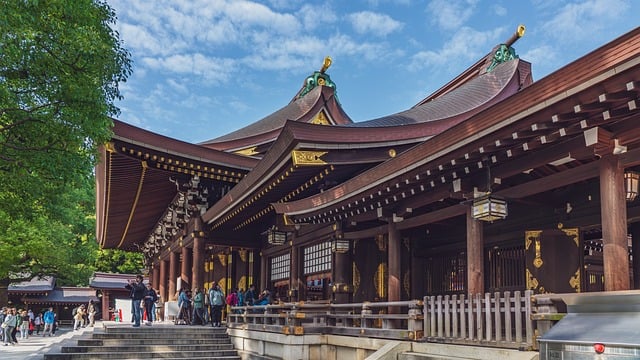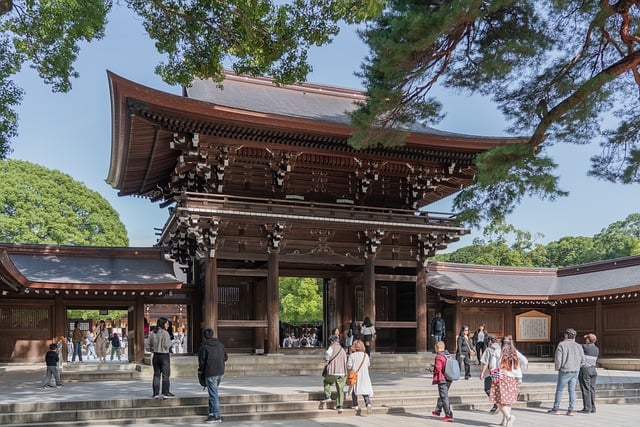Tokyo is often described as a city of contrasts, where dazzling neon lights, futuristic skyscrapers, and cutting-edge fashion coexist with centuries-old temples and serene gardens. Among these cultural treasures, Meiji Shrine (Meiji Jingu) stands out as one of the most iconic and spiritually significant sites in the capital. Nestled in a lush forest beside the trendy Harajuku district, the shrine offers visitors a peaceful retreat into nature and tradition, away from the fast-paced rhythm of urban life.
Meiji Shrine in Tokyo is a peaceful Shinto sanctuary surrounded by a lush forest, offering a glimpse into Japan’s spiritual traditions.
A Shrine Dedicated to Emperor Meiji and Empress Shoken

Meiji Shrine was built in 1920 to honor Emperor Meiji and his wife, Empress Shoken, who played key roles in Japan’s modernization during the late 19th century. Emperor Meiji was a central figure in the Meiji Restoration (1868–1912), a transformative era that opened Japan to the world after centuries of isolation. The shrine was constructed as a symbol of gratitude for their contributions and as a place where their spirits could be enshrined.
Although the original structure was destroyed during World War II air raids, the shrine was carefully rebuilt in 1958 with the help of donations from citizens across Japan. Today, it remains not only a sacred Shinto site but also a cultural landmark that attracts millions of visitors from around the world each year.
Entering Through the Grand Torii Gates
One of the most striking features of Meiji Shrine is its massive wooden torii gates, which mark the boundary between the busy city and the sacred forest. The largest of these gates, standing at over 12 meters tall, is made of 1,500-year-old cypress wood. Passing through these gates is considered a symbolic act of purification, as visitors leave behind worldly distractions and enter a space dedicated to the divine.
The main approach to the shrine is a long, wide gravel path shaded by towering trees. This peaceful walk, accompanied by the sound of crunching gravel underfoot and birdsong overhead, is an essential part of the experience. It encourages reflection, mindfulness, and a sense of connection with nature.
The Sacred Forest of Meiji Jingu
What makes Meiji Shrine unique is not only the shrine itself but also the 100,000-tree forest that surrounds it. These trees were donated from regions all over Japan when the shrine was established, creating an artificial yet natural-looking forest that has since thrived for over a century. Today, the forest is home to hundreds of plant and animal species, making it a rare pocket of biodiversity in the heart of Tokyo.
Walking through this lush environment feels like stepping into another world. Despite being just minutes away from the bustling shopping streets of Harajuku and Omotesando, the forest provides an atmosphere of quiet serenity, where visitors can sense the harmony between humanity and nature that is central to Shinto beliefs.
Rituals and Traditions
At the heart of Meiji Shrine lies the main hall (honden), where the spirits of Emperor Meiji and Empress Shoken are enshrined. Visitors cannot enter the inner sanctum but can offer prayers from the outer courtyard. The proper way to pay respects is to bow twice, clap twice, make a silent wish, and bow once more.
Another highlight is the ema boards, small wooden plaques on which visitors write prayers or wishes. These are hung on stands near the main hall and later offered to the deities by priests. Many tourists enjoy reading messages left by others, as they come in different languages and reflect the hopes of people from all around the world.
The shrine is also a popular place to witness traditional Shinto weddings. On weekends, it is common to see bridal processions in full ceremonial attire, with the bride in a white kimono and the groom in black robes. Tourists often pause to admire and photograph these timeless rituals, which showcase the enduring cultural significance of the shrine.
Seasonal Highlights
Meiji Shrine offers different experiences depending on the season. In spring, the forest comes alive with fresh greenery, while the nearby gardens display beautiful irises and azaleas. Autumn is particularly magical, as the gingko and maple trees turn vibrant shades of red and gold, creating breathtaking scenery along the shrine approach. In summer, festivals and ceremonies bring lively energy, while New Year’s is the busiest season of all, as millions of people visit Meiji Shrine for hatsumode, the first shrine visit of the year.
During hatsumode, the shrine welcomes over three million visitors within just a few days, making it one of the most popular New Year’s destinations in Japan. People come to pray for health, happiness, and success in the coming year, and the festive atmosphere is filled with food stalls, lucky charms, and traditional performances.
Cultural Treasures and Offerings
Near the main hall, visitors can view sake barrels (kazaridaru) stacked in impressive displays. These barrels are donated by sake brewers across Japan as offerings to the deities, symbolizing prosperity and celebration. On the opposite side, barrels of French wine are displayed, representing Emperor Meiji’s fondness for Western culture and his role in Japan’s modernization.
The shrine also features a treasure museum, which houses artifacts related to Emperor Meiji and Empress Shoken, including clothing, personal items, and historical documents. This museum provides deeper insight into the lives of the imperial couple and the era they shaped.
Accessibility and Location
Meiji Shrine is conveniently located just steps away from Harajuku Station and Meiji-jingumae Station, making it easy to access for both locals and international travelers. Its proximity to popular districts like Harajuku, Omotesando, and Shibuya makes it an ideal stop on any Tokyo itinerary. Many visitors combine a spiritual walk through Meiji Shrine with shopping in Harajuku’s Takeshita Street or enjoying modern art and fashion along Omotesando.
A Place of Harmony Between Tradition and Modernity
What makes Meiji Shrine so captivating is the way it embodies the spirit of Tokyo itself: a city that balances the new and the old. While skyscrapers and fashion trends rise just beyond the forest, inside the shrine grounds time seems to slow down. Visitors are reminded of Japan’s spiritual roots, its reverence for nature, and the quiet dignity of Shinto traditions.
For tourists, Meiji Shrine is not just a sightseeing spot but also an invitation to reflect. Whether one comes to pray, admire the natural beauty, or simply escape the noise of the city, the shrine offers an experience that touches both the heart and soul.



comment